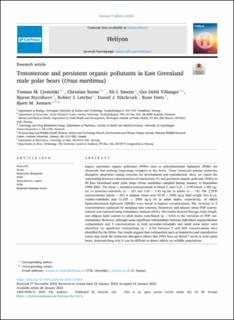| dc.contributor.author | Ciesielski, Tomasz Maciej | |
| dc.contributor.author | Sonne, Christian | |
| dc.contributor.author | Smette, Eli I. | |
| dc.contributor.author | Villanger, Gro Dehli | |
| dc.contributor.author | Styrishave, Bjarne | |
| dc.contributor.author | Letcher, Robert J. | |
| dc.contributor.author | Hitchcock, Daniel James | |
| dc.contributor.author | Dietz, Rune | |
| dc.contributor.author | Jenssen, Bjørn Munro | |
| dc.date.accessioned | 2023-10-24T14:32:08Z | |
| dc.date.available | 2023-10-24T14:32:08Z | |
| dc.date.created | 2023-04-17T17:54:57Z | |
| dc.date.issued | 2023 | |
| dc.identifier.citation | Heliyon. 2023, 9 (3), . | en_US |
| dc.identifier.issn | 2405-8440 | |
| dc.identifier.uri | https://hdl.handle.net/11250/3098505 | |
| dc.description.abstract | Legacy persistent organic pollutants (POPs) such as polychlorinated biphenyls (PCBs) are chemicals that undergo long-range transport to the Arctic. These chemicals possess endocrine disruptive properties raising concerns for development and reproduction. Here, we report the relationship between concentrations of testosterone (T) and persistent organic pollutant (POPs) in 40 East Greenland male polar bears (Ursus maritimus) sampled during January to September 1999–2001. The mean ± standard concentrations of blood T were 0.31 ± 0.49 (mean ± SD) ng/mL in juveniles/subadults (n = 22) and 3.58 ± 7.45 ng/mL in adults (n = 18). The ∑POP concentrations (mean ± SD) in adipose tissue were 8139 ± 2990 ng/g lipid weight (lw) in juveniles/subadults and 11,037 ± 3950 ng/g lw in adult males, respectively, of which Σpolychlorinated biphenyls (ΣPCBs) were found in highest concentrations. The variation in T concentrations explained by sampling date (season), biometrics and adipose tissue POP concentrations was explored using redundancy analysis (RDA). The results showed that age, body length, and adipose lipid content in adult males contributed (p = 0.02) to the variation in POP concentrations. However, although some significant relationships between individual organochlorine contaminants and T concentrations in both juveniles/subadults and adult polar bears were identified, no significant relationships (p = 0.32) between T and POP concentrations were identified by the RDAs. Our results suggest that confounders such as biometrics and reproductive status may mask the endocrine disruptive effects that POPs have on blood T levels in male polar bears, demonstrating why it can be difficult to detect effects on wildlife populations. | en_US |
| dc.language.iso | eng | en_US |
| dc.publisher | Elsevier | en_US |
| dc.rights | Navngivelse 4.0 Internasjonal | * |
| dc.rights.uri | http://creativecommons.org/licenses/by/4.0/deed.no | * |
| dc.title | Testosterone and persistent organic pollutants in East Greenland male polar bears (Ursus maritimus) | en_US |
| dc.title.alternative | Testosterone and persistent organic pollutants in East Greenland male polar bears (Ursus maritimus) | en_US |
| dc.type | Peer reviewed | en_US |
| dc.type | Journal article | en_US |
| dc.description.version | publishedVersion | en_US |
| dc.source.pagenumber | 10 | en_US |
| dc.source.volume | 9 | en_US |
| dc.source.journal | Heliyon | en_US |
| dc.source.issue | 3 | en_US |
| dc.identifier.doi | 10.1016/j.heliyon.2023.e13263 | |
| dc.identifier.cristin | 2141398 | |
| cristin.ispublished | true | |
| cristin.fulltext | original | |
| cristin.qualitycode | 1 | |

